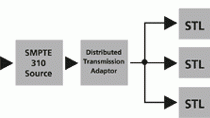Axcera offers distributed transmission technology

The DXA2B Distributed Transmission Adaptor (DTA) was introduced at this year's NAB. This adaptor is installed downstream from the SMPTE310 source. The output of the DXA2B is a slightly modified SMPTE 310 signal. The DTA replaces SMPTE 310 null packets with packets that contain the main ATSC modulator source’s trellis coder and pre-order states. The DTA determines this by using its own ATSC encoding model to determine the initial states of the master ATSC modulator. The modified SMPTE 310 signal is then fed to the slave transmitters via STL or other links.
Distributed Signal Adapter ensures that all slave transmitters produce the same modulated RF envelope.
ATSC modulators output states are not deterministic. Fed the same input data ATSC modulators usually come up with different symbol sequences. The ATSC standard does not impose any particular value upon the initial states of the modulators trellis coder, pre-coder, and the insertion points of the field sync, which occurs once every 312 MPEG packets. The slave modulators use the added data to set the initial states of its modulators. The timing of each modified SMPTE 310 stream fed out to each slave can also be changed in time so that all are in sync no matter what the path propagation time to each slave is.
With all transmitters producing the same envelope or symbol sequence there will be signal augmentation at the receiver and no chance of one transmitter actually “jamming” another. This system could allow ATSC coverage to be arranged as “cells” and even eliminate the need for a single large transmitter and associated facility.
Axcera points out that this is a major step past the synchronous booster approach. A synchronous booster receives a signal from the main transmitter, usually down-converts the received signal to an intermediate frequency, and then is converted back to the channel frequency using the same local oscillators. Thus it is on the same frequency but with a time delay. Synchronous boosters require substantial isolation between their transmit and receive antennas to avoid regeneration. This fact often limits the possible power out of the booster.
Axcera is currently working on a project with WPSX-DT in State College, PA in which they are implementing a distributed transmission network. This is being done on an experimental license and is the only network of its type.
For more information visit www.axcera.com
The professional video industry's #1 source for news, trends and product and tech information. Sign up below.
